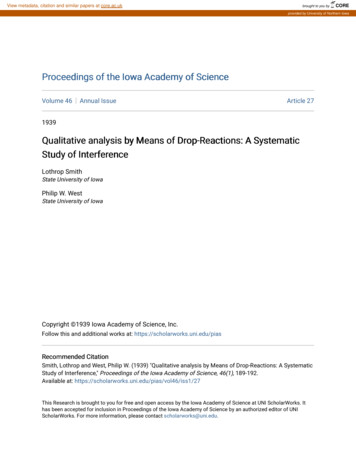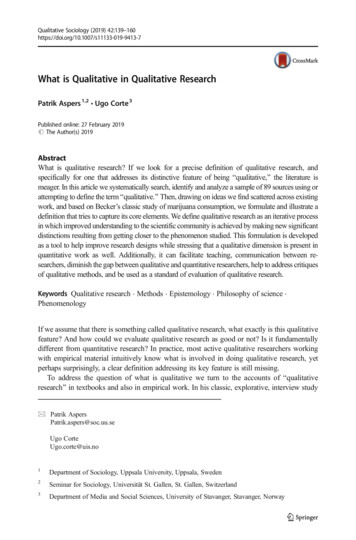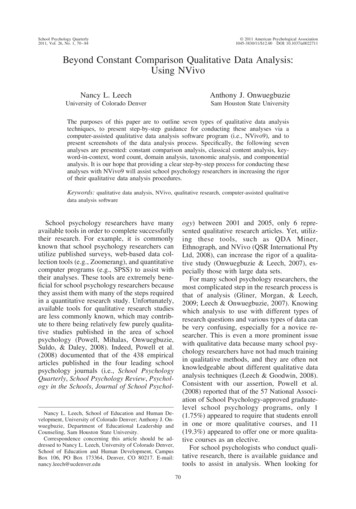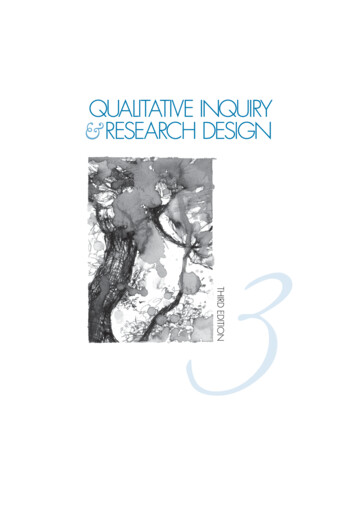
Transcription
View metadata, citation and similar papers at core.ac.ukbrought to you byCOREprovided by University of Northern IowaProceedings of the Iowa Academy of ScienceVolume 46Annual IssueArticle 271939Qualitative analysis by Means of Drop-Reactions: A SystematicStudy of InterferenceLothrop SmithState University of IowaPhilip W. WestState University of IowaCopyright 1939 Iowa Academy of Science, Inc.Follow this and additional works at: https://scholarworks.uni.edu/piasRecommended CitationSmith, Lothrop and West, Philip W. (1939) "Qualitative analysis by Means of Drop-Reactions: A SystematicStudy of Interference," Proceedings of the Iowa Academy of Science, 46(1), 189-192.Available at: s Research is brought to you for free and open access by the Iowa Academy of Science at UNI ScholarWorks. Ithas been accepted for inclusion in Proceedings of the Iowa Academy of Science by an authorized editor of UNIScholarWorks. For more information, please contact scholarworks@uni.edu.
Smith and West: Qualitative analysis by Means of Drop-Reactions: A Systematic StuQUALITATIVE ANALYSIS BY MEANS OF DROPREACTIONS: A SYSTEMATIC STUDYOF INTERFERENCELOTHROP SMITH AND PHILIP\V.\VBSTIn a previous paper ( 1), the authors presented a system ofqualitative microanalysis by means of drop tests based on a sodiumcarbonate-sodium peroxide separation. As was pointed out at thattime, the separation gives two groups, namely the "aqueous" gToup,which consists mainly of elements that yield water-soluble carbonates and hydroxides, and the "acid" group which is made upchiefly of elements that give insoluble carbonates and hydroxides.It was further pointed out that one of the main advantages of thesystem offered was that the oxidation by the sodium peroxideyields the elements in a constant state of oxidation, usually thehighest. This adjustment of valence has two main advantages;first, since all forms of an element are converted to one commonvalence, many tests are eliminated; second, the elimination ofextra valence forms reduces the possible interferences and makesinterference studies much more simple.Because so many tests reported in the literature are checkedfor only those interferences that might be found in the particularqualitative group in question, and because the type of interferencefound was seldom given, it was deemed advisable to check the testsused in the new system.The reagents, apparatus and tests used were described in a previous paper ( 1). The solutions of "knowns" were made by fusinga weighed quantity of the substances to be investigated withsodium peroxide and sodium carbonate. The melt thus obtainedwas crushed, leached with hot water, and finally neutralized withnitric acid. Solutions obtained by the above procedure containedthe elements in the same state of oxidation as would ordinarily hefound in actual laboratory analysis using the new system.l\fETHOD OF INVESTIGATIONBecause of the varied forms of phosphate interference, specialattention was paid to the behavior of this element. The followingoutline of procedure was used throughout the investigation, andwas applied in turn to each element considered.Published by UNI ScholarWorks, 1939 1891
Proceedings of the Iowa Academy of Science, Vol. 46 [1939], No. 1, Art. 27IOWA ACADEMY OF190SCIE CE[VoL. XLVI1.2.3.4.BlankElement under investigationElement phosphatePeriodic group IPeriodic group IIPeriodic group III etc.5. Periodic group I elementPeriodic group II elementPeriodic group IIT element etc.6. Periodic group I phosphatePeriodic group II phosphatePeriodic group IIIphosphate etc.7. Periodic groupI element phosphatePeriodic group IIelement phosphatePeriodic group III element phosphate etc. The interferences found were reported as being positive if afalse test was obtained and negative if the test was prevented.Partial inhibiting of tests and masking of tests due to highlycolored ions were also noted.Elements investigated were :I : Lithium, sodium, potassium, copper, silver, and gold.II: Beryllium, magnesium, calcium, zinc, strontium, cadmium, andbarium.Group III : Boron and aluminum.Group IV: Silicon, titanium, zirconium, tin, lead, and thorium.GroupV: Nitrogen, phosphorus, vanadium, bismuth, arsenic, and antimony.Group VI: Sulfur, chromium, selenium, molybdenum, tungsten, uranium.Group VII: Fluorine, chlorine, manganese, bromine, iodine.Group VIII: Iron, nickel, cobalt.GroupGroupCONCLUSIONSA complete investigation of interferences has been made for thetests used in the detecting of thirty-nine elements. It was foundthat the interferences listed in the literature (2, 3, 4) were veryincomplete in many cases, and in none of the tests described wasthe completeness of the interference studies given. Because ofthe lack of space a complete record of the present findings can notbe included. However, the following typical example will serve togive an idea of the state of our present knmvledge of interference.ALUMINUM (Aqueous group)1 d. soln. on a spot plate, 1 d. NaOH(N/10), 1 d. alizarin S.,2 d. acetic acid. In the presence of aluminum a pink color /iss1/272
Smith and West: Qualitative analysis by Means of Drop-Reactions: A Systematic Stu1939) QUALITATIVE ANALYSIS USING DROP-REACTIONS191Run blank.Interferences:Blank.Yell ow colorAluminum. Pink colorAluminum HP0 4 . . . . . . . Pink colorGroupIIIIIIIVvVIVIIVIII-Al Al-Al HP04 Al HP0 4 (1) (2) (3) (4) (5) (6) 1. Copper gave a positive interference. Large amounts of silver ga\·e a slightoff-color brownish tint to the blank and a deeper red to the aluminumcolor.2. Barium gave a positive interference.3. Zirconium, lead, and thorium gave positive interferences.4. Vanadium gave a fals-e test when present in large amounts. Very highconcentrations of bismuth interfered positively.5. Molybdenum and chromium interfered as thc:y gave stains similar tothat of aluminum.6. Iron gave an off-color brown. Very large amounts of cobalt and nickelgave positive interferences.Observations: The test drop should be alkaline prior to the addition of thealizarin sulfonate; the final acidity, however, should be below a paH of4. Molybdenum, chromium and vanadium are the only interfering substances when the sodium carbonate-sodium peroxide separation is used.If they are found o be present they may be removed by precipitationwith BaCl?. The excess BaCl? must then be removed by adding)Ba(OH) 2 , -evaporating to dryne;s, taking up in 2 d. H O and filtering.The interferences listed for this test by Feigl are: Iron, cobalt,nickel, alkaline earths and chromates. Lange's Handbook gaveiron, nickel, chromium and manganese as being interfering ions.As is shown by the above data, the interferences due to cobalt,manganese, calcium, and strontium could not be confirmed. Inaddition the following elements were found to give interferencesalthough they were not listed by Feigl or Lange's Handbook:Copper, zirconium, lead, thorium, bismuth and molybdenum.Of all the interferences found, only molybdenum, ch,romium,and vanadium appear in the same group as aluminum.Published by UNI ScholarWorks, 19393
Proceedings of the Iowa Academy of Science, Vol. 46 [1939], No. 1, Art. 27192IOWA ACADEMY OF SCIENCE[VoL. XLVIBIBLIOGRAPHY1. SMITH, loTHROP, and WEST, PHILIP. Proc. Iowa Acad. XL V.2. FEIGL, FRITZ, "Spot Tests," Nordman Publishing Co., New York City,1937.3. Lange's Handbook of Chemistry, Handhook Publishers, Inc., Sandusky,Ohio, 1937.4. BENEm:TT1-P1CHLER, A. A., "Introduction to the Micro 11nique of Inorganic Qualitative Analysis," Microchemical Service, Dou ·1:,ston, N.Y., 1935."'DEP.ARTMEK1' OF CHEMISTRY,STATEOFUNIVERSITYlowA,low A CITY, low A.https://scholarworks.uni.edu/pias/vol46/iss1/274
The interferences listed for this test by Feigl are: Iron, cobalt, nickel, alkaline earths and chromates. Lange's Handbook gave iron, nickel, chromium and manganese as being interfering ions. As is shown by the above data, the interferences due to cobalt, manganese, calcium, and strontium could not be confirmed. In











